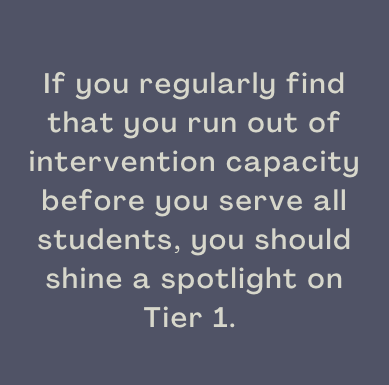Should we focus on Tier 1?
I worked with a building leader who told me, “We’ve been focusing on Tier 1 since NCLB. We want to learn new interventions!”
I sympathize! Tier 1 is definitely not the sexy part of an MTSS. Schools flock to MTSS frameworks to provide interventions to students who struggle. I will never suggest preventing students from receiving interventions, or ceasing to ensure those interventions being provided are evidence-based and implemented as intended. Yet, many times schools aren’t seeing overall student achievement increase because Tier 1 resources need to be the focus of improvement efforts. It can be tricky to know if you should focus your improvement efforts on the universal tier or supporting more students with interventions.
I’ll skip straight to the TL;DR - If you regularly find that you run out of intervention capacity before you serve all students, you should shine a spotlight on Tier 1. The good news is that when you focus on Tier 1 improvements, all students benefit!
Now for the detailed discussion…
I’m often asked what the percent of proficiency is that we should be aiming for and I never begin that answer with a number because it’s different in every school. Schools with more interventionists and a stronger infrastructure (e.g. schedule) to support interventions and intensification can usually provide evidence-based interventions with fidelity to more students than those with fewer interventionists and a weaker infrastructure.
Ask yourself this:
Do we regularly have to get creative to get all students the interventions they need?
Or worse, are we in a place where we have to choose which students won’t receive the intervention support they need?
In these cases, we don’t have time not to focus on improving Tier 1! I know I should’ve changed the double-negative there, but just couldn’t bring myself to do it. Students are only in 1st grade (or 4th grade, or 8th grade, you get the picture) once, and every one of them deserves to make the most progress possible within this time.
Show Me the Data
Because I’m a “show me the data” person, let’s talk about the data you’ll use to evaluate the effectiveness of Tier 1. There are 2 common questions to ask. One looks at student performance (or level) on screening and the other considers student growth.
Question: What percent of students are on-track to meet grade level expectations?
To Answer: To answer this question, take your grade level screening data from the most recent screening window. If fewer than 80% of students are on-track, you have evidence that you need to focus on Tier 1 improvement and intensification.
The 80% number is a ballpark estimate that tends to align with the number of students that can be supported with interventions. As I said above, it could be higher or lower in your building, depending on your resources.
Question: What percent of students who started the year on track grew enough to stay on track?
To Answer: To answer this question, you’ll get screening data from 2 periods. Usually fall and winter or fall and spring, depending on the time of year. We’re only going to look at data for the students who started the year on track (because they likely received only Tier 1 resources). Consider which of those students who started on track grew enough to remain on track at the end of the year.
Most teachers would expect that all students who start the year on track end the year on track! No one wants to look at a parent and say, “Well, Sarah came in ready to rock and roll in 5th grade but now she’s behind where she needs to be. Have a great summer!”
With data on these two questions for your school, you’ll be able to start the conversation about focusing system improvement efforts on Tier 1. You can also use these data to prioritize grade levels and content areas for Tier 1 improvement and intensification and allocate local resources accordingly.
Potential Next Step
Leaders
Use your data to answer these 2 questions and then plan how you’ll share them with your district and/or building teams. Consider how to help others find the data on their own and the reflection questions you’d like teams to consider as they review the data.
All Educators
Do these calculations for your class or grade. Be a positive voice at your team meeting when reviewing universal screening data. Feel empowered to advocate for Tier 1 improvements and know that when you are, you’re supporting your teams and students.
Want to Learn More
In a future post, I’ll share what to do once you identify that you want to focus on improving Tier 1. In the meantime, I’ll leave you with a couple of suggestions of resources to dig into.
First, if you want to start exploring evidence-based reading and math curriculum and instruction, I recommend starting with The Reading League and The Science of Math. The organizations do work based on the evidence and have a lot of great resources on their sites.
Finally, the book, Effective Universal Instruction: An Action-Oriented Approach to Evaluating and Improving Tier 1, provides more information and team tools to engage in this evaluation.
If you’re interested in learning more or have specific questions you’d like to see addressed here, message me. And sign up here to keep up with all new System Savvy articles and resources.

